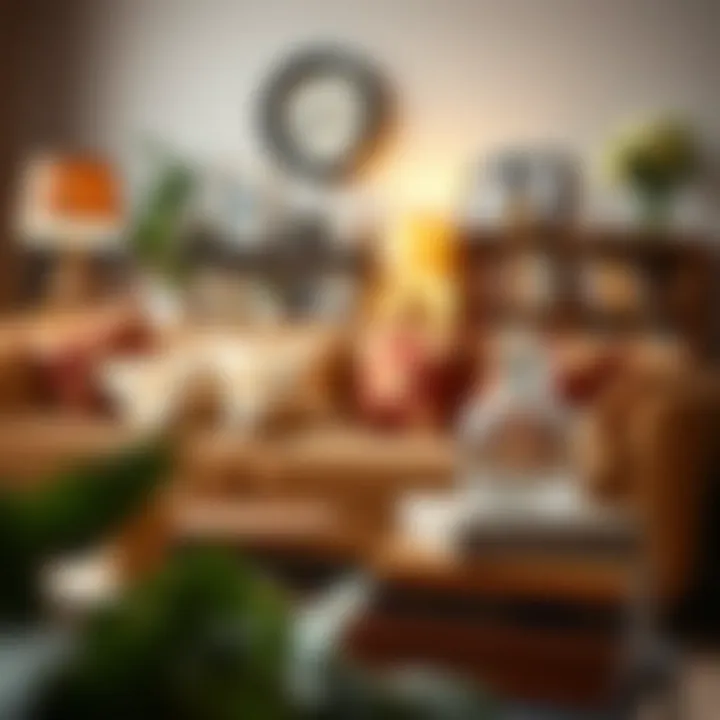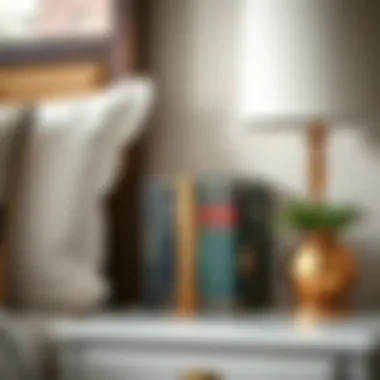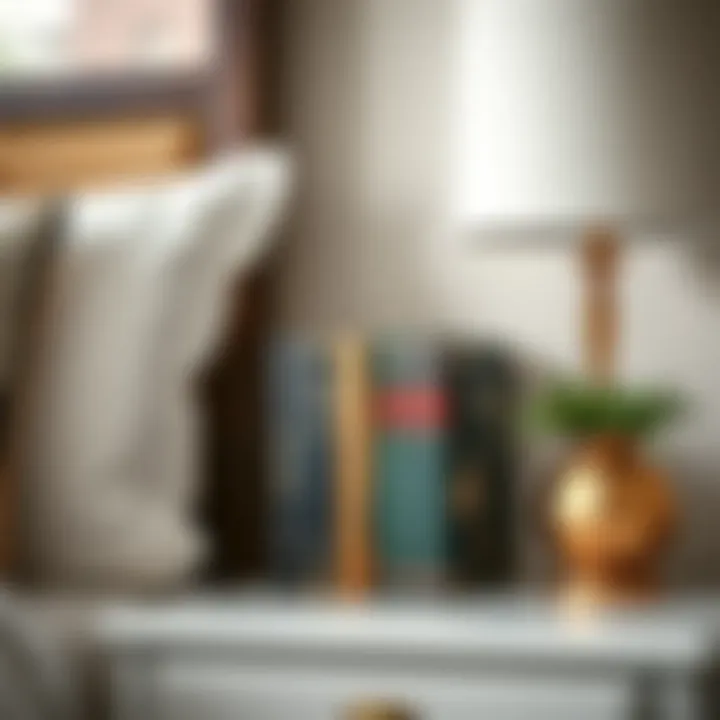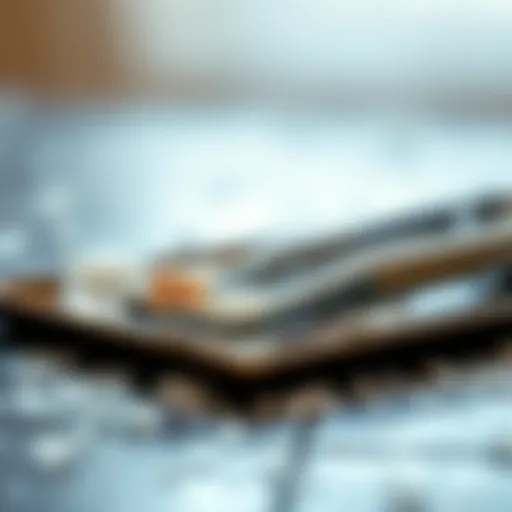Enhancing Home Decor with Decorative Books


Intro
Decorative books play a pivotal role in enhancing the aesthetics of any home. They are not merely objects that carry words; they ooze character and can infuse an environment with warmth, nostalgia, and sophistication. Books can tell stories, not just through their content but through their covers, colors, and the way they are displayed. This article explores how these literary treasures can transform spaces, resonate emotionally with the people in them, and serve as practical decor items.
As we dive into the various styles and themes associated with decorative books, it’s essential to consider their historical significance. Books have evolved from simple tools of knowledge to essential components of design that can bridge the gap between functionality and artistic expression. Whether you’re an avid reader or an occasional browser, the way you incorporate books into your interior design speaks volumes about your personality and taste.
We’ll navigate through innovative arrangements and the emotional resonance that decorative books can foster. This exploration will provide practical strategies to enhance your living environment, helping you reflect your individuality while creating inviting spaces.
Let’s embark on this journey and discover how decorative books can elevate your home decor in unexpected and delightful ways.
Understanding Decorative Books
In the realm of interior design, decorative books serve as more than just pretty objects lining shelves. Their significance lies in their ability to weave personal stories into the fabric of a space. When we explore decorative books, we delve into an intersection of art, literature, and expression that can illuminate the narrative of any home.
The benefits of using decorative books in decor extend beyond mere aesthetics. Here are some key considerations to take into account:
- Conversation Starters: A well-placed book can spark discussions, revealing insights into the owner’s personality.
- Layering and Texture: Books add depth and varying textures that can enrich visual composition in any space.
- Personalization: They provide an opportunity to highlight personal tastes, from classic literature to modern design.
As such, understanding decorative books encompasses recognition of their role as intentional design elements rather than mere fillers. The art of choosing and arranging these books carefully paves the way for a more cohesive home environment linking literary passion with design flair.
Definition and Characteristics
To appreciate decorative books fully, it's essential to define them distinctly. Decorative books usually feature attractive covers, often with artistic designs, elegant typography, or vibrant colors. While their content may be significant, their primary function revolves around aesthetics and display. These books are typically:
- Hardcover: Most decorative books boast a sturdy cover that exudes quality. They tend to hold up better as decorative pieces compared to paperbacks.
- Visually Striking: Many are chosen for their visual appeal; they may feature beautiful illustrations or photography that contribute to the ambiance of a space.
- Themed: Some decorative books align with specific themes, like travel, art, or fashion, offering not just visual value but also a glimpse into the owner’s interests.
The Evolution of Decorative Books
The lineage of decorative books traces back to ancient times when scrolls and manuscripts were hand-painted and adorned with intricate designs. As publication processes streamlined, books became more accessible, leading to a revolution in their design and purpose.
During the Victorian era, for example, books were often lavishly bound and ornamented. Home libraries became status symbols, and the display of books became an integral part of the home’s aesthetic appeal. Over the decades, as modernism took over, the focus shifted from ornate decorations to sleek, minimalist designs. However, decorative books never fell out of favor; they merely adapted.
In contemporary decor, there's a growing trend towards sustainable design, and decorative books are increasingly being selected for their eco-friendly production, either through the use of recycled materials or by supporting local artisans.
"Decorative books are not just for reading; they can transform your home into a canvas of your intellectual and artistic pursuits."
In summation, the evolution of decorative books illustrates their enduring appeal, morphing from fundamental reading materials to essential components in enhancing the aesthetic value of a living space. Their ability to reflect personal charm while serving functional roles, through thoughtful curation and display, makes them an invaluable asset in home decor.
The Aesthetic Value of Decorative Books
The realm of home decor greatly benefits from the inclusion of decorative books. These vibrant pieces are not merely objects of intellectual pursuit; they infuse spaces with character and elegance. They bridge the gap between functionality and artistic expression, making them paramount in any design conversation. Whether sitting quaintly on a coffee table or stacked stylishly on a shelf, decorative books serve a dual purpose: they are both beautiful and a reflection of personal style.
Visual Appeal and Texture
When one looks at environmental design, textures play a crucial rôle in shaping visual experiences. Decorative books lend a fascinating tactile quality that contrasts with other decor elements like glass or metal. Their covers often showcase rich fabrics, embossed designs, or striking illustrations that draw the eye. For instance, imagine a rustic wooden bookshelf housing a collection of vintage travel tomes, their spines worn yet enchanting, calling to mind stories of adventure and far-off lands.
Incorporating varied textures through the medium of books can enliven a space. The smooth finish of a coffee table book can be complemented by the rough edges of a leather-bound classic. Layering these contrasting materials creates depth in design. When stacked, choices about how to showcase each book—full face or spine out—can radically alter the mood of a room.
Color Schemes and Themes
Decorative books seamlessly tie into color schemes and thematic styles. Color is often the first thing that catches the eye in interior design; it sets the tone of the room. Books with elegant color palettes can serve as focal points among more subdued decor. For example, a series of books with earth tones can warm up a modern, minimalist space, while vibrant covers can add energy to a monochromatic setting.
Moreover, arranging books by themes can create a narrative thread throughout your space. A collection focused on 20th-century art can inspire conversation and pique curiosity. Alternatively, a selection of culinary books can enhance a kitchen's decor while offering utility for the home chef. This thematic approach can be visually compelling and intellectually stimulating, making the decor not just personal, but also deeply engaging.
Integrating with Art and Decor
Books can become subtle sculptural elements when integrated thoughtfully with art and decor. Picture an elegantly framed print elevated against a backdrop of three or four carefully chosen decorative books. This trio could vary in size, offering a dynamic visual rhythm that evokes interest and invites exploration. Decorative books nestled amongst art pieces can create a layered look that feels curated rather than contrived.
Integrating decorative books with art allows for creative rearrangements. One could use books to prop up a small sculpture or serve as a stand for a decorative object, blending literature with visual arts effortlessly. Moreover, creating a cohesive display with colors that are mirrored in the artwork can tie a room together, giving it depth and a polished appeal.


In the world of decor, the informed choice of decorative books enhances not just the aesthetic, but the overall atmosphere of a space.
By understanding and leveraging these elements, decorators can elevate their interior spaces, cultivating a warm and inviting environment that speaks volumes—without uttering a word.
Practical Applications of Decorative Books
In the realm of interior design, decorative books serve versatile purposes that extend far beyond mere aesthetics. They can enhance the overall ambience of a room while also reflecting personal history and taste. Using decorative books effectively combines savvy design choices with functionality. This dual role of decorative books not only beautifies a space but also imbues it with character. Here, we explore two critical aspects: Creative Stacking and Arrangement and Functional Display: More than Aesthetics.
Creative Stacking and Arrangement
When it comes to incorporating decorative books, stacking and arranging them can be a true art form. The way books are stacked can create intriguing visual lines and balance in a room. Here are a few effective methods to consider:
- Vertical and Horizontal Stacking: Mixing vertical and horizontal arrangements allows for a dynamic display. Place some books upright while stacking others atop them to add dimension. Your collection doesn’t have to follow a straight arrow; it can diverge like a winding river.
- Utilizing Surfaces Smartly: Coffee tables, shelves, or side tables serve as great surfaces for stacks of decorative books. Imagine a quaint stack of hardcover novels topped with a unique sculpture or a chic candle—it creates an inviting atmosphere and invites interaction.
- Grouping by Theme or Color: Building small groups of books based on themes—like travel or art—can create a narrative, encouraging conversations. This allows the decor to resonate more personally with the inhabitants.
"Decorative books don't just sit pretty; they tell stories through stacking, creating landscapes of culture and intellect."
In essence, how you stack your books can turn an ordinary space into a gallery of stories. Each grouping, carefully conceived, adds a level of context and encourages a deeper appreciation of the volumes.
Functional Display: More than Aesthetics
Beyond serving as mere decorative elements, books hold several practical applications in design. They are woven into the fabric of daily living and offer functions that are often overlooked. Here’s how to maximize their utility:
- Improving Organization: Books can act as partitions. A stack can divide spaces without the necessity of a wall. This helps to harmonize open-concept layouts, lending a visual pause.
- Accessorizing Spaces: Books complement various decor items, serving as platters for small decor. They can also be bases for vases or decorative trays. Instead of placing a vase directly on a table, placing it on a stack of books can elevate the visual interest, creating layers in design.
- Hosting and Accessibility: Consider how often guests flip through a coffee table book. Having some decorative options readily accessible encourages interaction, offering guests a glimpse into your taste and interests. It's like leaving breadcrumbs of who you are, letting your collection spark dialogue.
Themes and Genres for Decor
Classic Literature and Art
Classic literature and art books offer rich visual appeal and engaging narratives that resonate with many.\nThese books act as more than just decoration; they shape an intellectual landscape within your home. Consider the idea of placing a collection of Jane Austen novels atop a chic coffee table. Not only does this selection add charm, but it also invites guests to delve into discussions about love, society, and the artful prose of the Regency era.
Moreover, books featuring classic artwork, like those showcasing Van Gogh, can pull together different elements in a room, echoing colors found in your decor. Integrating such themes interspersed with decorative content can turn simple stacks into striking focal points.
Fashion and Design Literature
The world of fashion and design literature captures contemporary trends while paying homage to historical movements. Incorporating these titles can significantly uplift the aesthetic level of a space. Imagine displaying glossy hardcovers of Coco Chanel or Alexander McQueen on a stylish shelf. These striking visuals do more than sit pretty; they demonstrate an appreciation for cultural shifts and creativity.
In living spaces characterized by sleek lines and modern textures, these books weave the narrative of innovation into the structure, adding layers of intrigue and sophistication. They can serve as conversation starters and inspire new ideas for style and decor.
Travel and Nature Books
Travel and nature books bring a slice of the world into your home, infusing it with a sense of adventure and exploration. Whether it's the vibrant pictures of exotic landscapes or tales from the road, these volumes create an inviting ambiance that beckons guests to share their own journeys.
Arranging travel books next to a globe, or showcasing a large coffee-table book filled with stunning photography of wild parks, can make a living room feel expansive and free-spirited. This theme resonates particularly well in settings filled with natural elements—wood, stone, and plants—making it feel cohesive and thoughtfully designed.
Ultimately, the themes you choose for decorative books can transform a space. It’s about more than displaying books; it’s about weaving stories and emotions into your home's narrative. In doing so, they not only contribute style but also reflect the essence of who you are.
The Impact of Decorative Books on Atmosphere
Decorative books do more than just occupy space on a shelf; they contribute significantly to the overall atmosphere of a room. In design, atmosphere is often defined as the emotional tone set by the physical environment. The presence of books can enrich a space in many ways, from creating a sense of coziness to enhancing elegance and sophistication. Analyzing the impact of these books reveals their role in shaping the mood and emotional undertones of our living environments.
Creating a Cozy or Elegant Space
When thinking about how decorative books can infuse warmth into your home, consider their ability to create a cozy ambiance akin to wrapping oneself in a beloved blanket. The texture and character of books—whether leather-bound, weathered, or artfully illustrated—offer a tactile experience that can invite comfort. Displaying these books on coffee tables, bookshelves, or even a favorite armchair adds layers of interest that make an area feel lived-in and welcoming.
- Layering: Position books in stacks with varying dimensions. A larger book can serve as a base, topped with smaller editions to create visual variety.
- Color palettes: Choose books that harmonize or contrast with the existing color scheme of your decor. Books with covers in warm tones can enhance the coziness of a space, while brighter shades might add vibrancy and energy.
On the other hand, the strategic use of specific books can elevate any room's atmosphere to one of refined elegance. An arrangement of carefully curated decorative books—perhaps titles related to art and design—can communicate sophistication. Think about that sophisticated reading nook adorned with gold-leaf books against a rich leather chair, betraying nothing but pure class.
"Books are a uniquely portable magic." —Stephen King


Emotional Connections through Literature
Books hold an innate power to evoke memories and emotions. Whether it's a novel that once captured your imagination or a beautiful coffee table book featuring breathtaking landscapes, these items often serve as nostalgia anchors. When incorporated into your decor, they become conversation starters that engage visitors and spark stories. People feel an emotional connection to places, experiences, or moments encapsulated within their pages.
Moreover, literature often reflects personal journeys or aspirations—a reminder of where you’ve been or where you dream to go. When you align your choice of decorative books with personal experiences, you enrich your home as it evolves into a narrative that is distinctly yours. Consider participating in the emerging trend of personal libraries that curate not just for aesthetics but to resonate deeply with the homeowner’s identity and experiences.
In this way, your home transforms into a tapestry of stories, where every decorative book contributes its thread. By integrating books that inspire or resonate emotionally, you create a space that feels authentic and meaningful.
Choosing the Right Books for Your Decor
When it comes to home decor, decorative books play a pivotal role. They serve not just as ornaments but as conversations starters and reflections of your identity. Choosing the right books can transform a drab corner into a rich tableau of color, texture, and interest, all while whispering stories and passions to those who encounter them. It’s about connecting with what resonates with you visually and personally.
Identifying Personal Preferences
To curate a stunning collection of decorative books, you first need to dive into your preferences. This might seem like a no-brainer, but the spectrum of styles, genres, and colors available can be overwhelming. Think about what you genuinely enjoy. Are you drawn to vivid photography books filled with images of far-off places? Or perhaps you gravitate toward the sophisticated simplicity of classic literature with elegant spines?
Start by askng yourself these questions:
- What themes resonate with me? Consider your passions, whether they are travel, fashion, art, or even history.
- What colors align with my existing decor? Consider the hues of your living space. Do you prefer a monochromatic look, or is a burst of color more your style?
Additionally, browse local thrift stores or secondhand shops. These destinations often hold gems that can align perfectly with your aesthetic. By choosing books that reflect your interests, you’ll craft a decor scheme that feels authentic and inviting.
Assessing Compatibility with Existing Decor
Once you've pinpointed your personal tastes, the next step is to ensure your chosen books blend harmoniously with your existing decor. It’s essential to assess the current colors, patterns, and overall vibe of your space.
Ask yourself:
- Do I prefer a cohesive look or an eclectic mix? If your style is more contemporary, opt for books with clean lines and modern covers. If you favor a bohemian style, mixing vintage and eclectic finds might work wonders.
- How do the books interact with surrounding decor elements? Consider how your decorative books will sit alongside other decor pieces, like artwork or plants. You may want a color palette that either complements or contrasts effectively.
"Books are a uniquely portable magic." – Stephen King
In integrating decorative books into your home, consider the size, shape, and layout of both the books themselves and the surrounding objects. A broad, flat art book might serve well on a coffee table, while sleek, slim volumes could be ideal for nesting alongside a statement piece on a shelf. This thoughtful compatibility can elevate the overall design and create a seamless flow throughout your space.
Transforming your home with decorative books is an art in itself, requiring both a bit of introspection and a keen eye for design. The right books can speak volumes about who you are while enhancing the beauty and character of your surrounding environment, making it a cozy sanctuary that feels utterly unique.
Caring for Decorative Books
In the world of interior design, decorative books serve as more than just items on a shelf; they shape the narrative of your space. Caring for these cherished items is essential not only for their longevity but also for maintaining the integrity of your decor. Proper care can prevent wear, and tear and ultimately enhance the aesthetic value of your home.
The practice of maintaining decorative books involves various facets – from understanding the right environment they thrive in to implementing effective preservation techniques. This section unpacks practical steps you can take to ensure your books remain a visually pleasing element of your decor while being protected from damage and decay.
Maintenance and Preservation Tips
When it comes to keeping decorative books in top shape, a bit of forethought goes a long way. Here are some key maintenance tips:
- Dust Regularly: Dust can accumulate quickly, so use a soft, dry cloth or a gentle feather duster to keep your books clean. It helps preserve the spine and cover, preventing fading and degradation.
- Position Them Properly: Avoid placing books near sunlight or in humid conditions. This can lead to warping, discoloration, and unwanted moisture buildup, which can metaphorically spell disaster for your beloved tomes.
- Use Bookends Wisely: Bookends not only serve a functional purpose but also keep books upright, reducing the risk of bending or crumpling spines. Choose a bookend that matches your decor style for an added visual flare.
- Avoid Eating or Drinking Nearby: I know it sounds simple, but setting food and drinks close to decorative books can lead to spills that will ruin them. Being cautious can save those beautiful pages from oblivion!
Implementing these strategies can significantly extend the life of your decorative books, allowing them to continue enriching your living space.
Selecting Suitable Display Conditions
Creating the right conditions for displaying your decorative books is key to both their care and their aesthetic impact. The following considerations will ensure that your books are showcased to their best advantage:
- Choose the Right Shelving: Invest in well-structured shelves that can bear the weight of your books without sagging. A strong shelf keeps books safely stored and prominently displayed, turning them into an effortless part of the decor puzzle.
- Light Exposure: While a bit of natural light can enhance the ambiance, too much can lead to fading and deterioration. Opt for a location where books can be enjoyed yet somewhat shielded from direct sunlight, possibly supplemented by warm artificial lights in the evening to create a cozy reading nook.
- Temperature and Humidity Control: The ideal indoor climate for books is cool and dry. Aim for a temperature around 65°F to 70°F and humidity levels of around 40% to 50%. Too much humidity invites mold; too little leads to brittle pages.
"The right display conditions can be just as important as the books themselves, which serves as the icing on the cake when it comes to home decor."
- Keep Them Accessible: While you may want to keep your decorative books pristine, hiding them away negates their visual impact. Incorporate them into your decor in a way that invites guests to explore them, creating a conversation starter while maintaining visual beauty.


Ultimately, taking care to maintain and display decorative books not only elevates their condition and lifespan but also enhances the overall feel of your space, resonating with the story you wish to tell in your home.
Innovative Display Techniques
Using Decorative Bookends and Stands
Decorative bookends and stands are a simple yet effective way to add flair to your book display. Not only do they keep books organized, but they also act as a decorative element in themselves. Customized bookends, whether they be made from wood, metal, or even stone, can reflect a theme or color scheme prevalent in the room. For instance, sleek metal bookends can complement a contemporary style, while wooden ones may exude a rustic charm.
When arranging books, consider varying the orientation; laying some books flat and standing others upright creates movement and visual interest. Placing a small potted plant or decorative object on the flat books can also break the lines and add a refreshing touch. Using stands for larger coffee table books elevates them, literally and figuratively, allowing them to catch the eye and become conversation starters.
- Benefits of using decorative bookends and stands:
- They provide stability and support for heavier books.
- They can transform a simple shelf into a curated display.
- They enhance the color palette and texture of the room.
Incorporating Books into Gallery Walls
Gallery walls are not confined to just art and photographs. The inclusion of decorative books can breathe new life into this design concept. By treating books as artwork, you can create a unique blend of visual storytelling. A well-placed set of books among traditional artwork can evoke a sense of intellectual curiosity and personality.
One innovative approach involves framing open books on the wall, displaying their beautiful illustrations or cover designs. This is particularly effective with vintage or artistically designed volumes that may otherwise go unnoticed on a shelf. Alternatively, you can designate a section of the gallery wall for book covers. Using shadow boxes allows for a three-dimensional effect, making the display more dynamic.
To maintain harmony within the gallery wall, ensure that the colors of the book spines complement the overall color scheme of the decor. This attention to detail will create a cohesive look that ties together all elements present on the wall.
- Considerations for books in gallery walls:
- Balance the size of books with the surrounding artwork.
- Pay attention to the flow, ensuring that the wall tells a story.
- Use sturdy brackets or hangers to secure books safely.
In summary, innovative display techniques enrich the use of decorative books in home decor. By employing decorative bookends and creatively integrating books into gallery walls, one can craft a personal narrative that reflects both aesthetics and character in living spaces.
Sustainable Choices in Decorative Books
In a world increasingly attuned to sustainability, decorative books have found their way into the eco-conscious home. Choosing sustainable options not only enhances aesthetics but also aligns with responsible consumption. This section delves into the importance of selecting eco-friendly books and supporting local publishers, issues that resonate with discerning readers and decorators alike.
Selecting Eco-Friendly Options
When it comes to decorative books, opting for eco-friendly materials is crucial. Books made from recycled paper or those that use soy-based inks minimize environmental impact. Additionally, binders and covers crafted from sustainable resources, like bamboo or other fast-growing plants, contribute to a greener lifestyle.
Here are some considerations when selecting books:
- Look for certifications: Check for labels like Forest Stewardship Council (FSC) certified, which ensures sustainable forestry practices.
- Rescue and upcycle: Thrift stores or second-hand shops can be treasure troves. Finding old books, reviving their purpose as décor, and giving them a new life could resonate well.
- Digital alternatives: While not precisely decorative, digital formats can help reduce paper waste. Consider this for displaying book covers or even showcasing virtual libraries in photo frames.
Remember, every little choice counts. Your book selection can reflect your values while adding style to your space.
Supporting Local and Independent Publishers
A significant yet often overlooked dimension of sustainable decor is the impact of supporting local and independent publishers. Buying books from local authors or small presses not only fuels the local economy but often results in uniquely crafted works you won't find in mainstream stores. This can significantly enhance the character of your decor.
Why does this matter?
- Quality over quantity: Independent publishers often focus on high-quality content and design. Their books may feature distinct styles, illustrations, or binding techniques, enriching your decor with originality and charm.
- Community and culture: By supporting local businesses, you're contributing to the local literary scene and culture, an integral part of any community's spirit.
- Unique finds: Many small presses create books that cater to niche interests, providing decorative options that align closely with personal style and interests. Imagine showcasing a beautifully illustrated book about local flora—what a conversation starter!
Incorporating decorative books into your home decor with a focus on sustainability elevates your living space and showcases your values. When art meets conscience, the outcome is genuine and beautifully authentic.
End
In wrapping up the exploration of decorative books and their role in enhancing home decor, we must reflect on their broader significance. Decorative books are not just pretty objects stacked on a shelf; they serve multiple functions that resonate with both aesthetics and functionality. For anyone looking to elevate their living space, understanding the lasting impact these books can have is key.
The Lasting Impact of Decorative Books on Decor
The essence of decorative books lies in how they can transform an ordinary space into something with character and depth. When artfully arranged, these books become conversation starters, infusing living spaces with a sense of personality and story. Here are some noteworthy aspects:
- Visual Interest: Aesthetically pleasing covers with unique texture and color can add layers to a room's design. Think of the differences between a bright orange book and a sea of muted gray decor; that splash of color can break monotony and energize the atmosphere.
- Intellectual Value: They evoke curiosity and can stimulate discussions. Guests might be intrigued by the novels or art books on display, opening pathways to intriguing conversations.
- Theme Cohesion: Decorative books can reinforce the overall theme of a room. Whether it’s a beach house adorned with travel literature or a sophisticated sitting room filled with classic literature, they tie everything together.
- Personal Reflection: Selecting books that reflect one’s interests or experiences allows a homeowner to personalize their space, showcasing passions that might not be visible otherwise.
- Emotional Resonance: Books carry memories and emotions. The presence of specific decorative books can create a comforting environment, reminding one of significant moments or journeys.
In summary, decorative books enrich home decor in ways that go beyond mere visuals. They combine beauty with practical purposes, offering an enduring charm that endears them to those who value design and literature alike. This synthesis of art and intellect truly makes decorative books indispensable in the realm of home styling.
For further reading on the intersection of literature and design, you may find resources at Britannica or explore community discussions at Reddit. Remember, the choices made about decor can say much about who you are and what you cherish.







